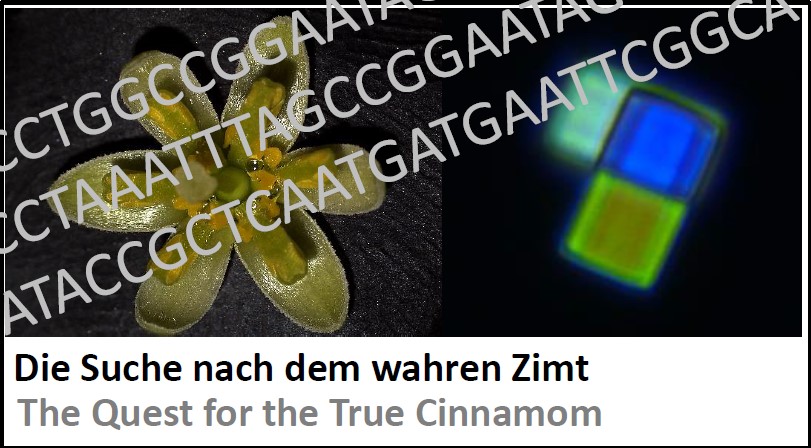 Plant Evolution 2022
Plant Evolution 2022
Cinnamom belongs to the most ancient genera of flowering plants and existed already at the time, before Pangaea broke up. Thus, it is found on almost all continents and has split up into numerous species that are very hard to identify. As aromatic plant, Asiatic Cinnamom species have been used for several thousands of years, for different purposes (as spice, as ailment, as perfume). The chemical reason for the aroma are mostly phenylpropanoids (the precursors for lignin and derivatives thereof), but also terpenoids such as camphor or borneol. The commercial value is quite variable, for instance Cassia Cinnamom (formerly C. aromaticum or C. cassia) is much cheaper than Ceylon Cinnamom (C. verum). In addition, several Southeast Asian species such as Saigon Cinnamom (C. burmannii) are traded as well and used for medicinal purposes. Some species contain high levels of coumarin, which is genotoxic and therefore problematic if ingested at higher quantities. This problem has become accentuated by a new trend for Cinnamom capsules that are used to cure type II diabetes and contain high concentrations of often undefined cinnamoms. We try to develop assays to detect coumarin-rich species in such products and have established a collection of cinnamoms in our Botanical Garden. The identity of our reference plants is key to any approach to authenticate food products by genetic barcoding. However, we have learnt that many of our species, which we got from other reputed Botanical Gardens or from commercial vendors, turned out to be not the species declared. The project will use a combination of genetic barcoding, molecular phylogeny, and phenotypic analysis to shed light into the dark. Poster Masterarbeit Claudia Swoboda . Scriptum with protocols . portraits of our cinnamoms (internal page, ask for the password) .
Genetic Barcoding
Wie gehen wir vor?
Zunächst investieren wir viel Aufwand in die Echtheit unserer Belegpflanzen, die wir im Botanischen Garten kultivieren und die wir mithilfe klassischer Bestimmung authentifizieren. Die Qualität einer Methode steht und fällt mit der Echtheit der Referenzpflanze. Daher tragen alle unseren Pflanzen einen Erkennungscode, der sich nie ändert, auch wenn sich der Name einer Pflanze ändert (das kommt nicht so selten vor - erstens wird die Taxonomie der Pflanzen immer wieder reformiert, wodurch sich auch Namen ändern, zweitens sind geschätzte 10-20% der Pflanzen in Botanischen Gärten oder Genbanken falsch bestimmt oder benannt, so dass sich oft Pflanzen, die wir von anderen Gärten bekommen, sich nach unserer Bestimmung als etwas anderes herausstellen). Im zweiten Schritt wird dann eine Datenbankanalyse nach vorhandenen genetische barcodes durchgeführt - je mehr Vergleichsmarker es gibt und je informativer die sind, umso eindeutiger werden die Ergebnisse sein. Es wird dann genomische DNS isoliert und dann werden die passenden barcoding marker über PCR amplifiziert und zum Sequenzieren geschickt. Parallel werden die Akzessionen mikroskopisch verglichen, interessante diagnostische Marker sind zum Beispiel Spaltöffnungsmuster oder die relative Größe Epidermiszellen / Palisadenparenchym, aber auch Haare, Trichome, Kristalle. Wenn die Sequenzen geliefert werden, werden diese mit Sequenzen aus den Datenbanken aliniert und daraus ein NJ-Baum erstellt. Dann werden geeignete Sequenzunterschiede ausgesucht, um daraus einen diagnostischen Test zu entwickeln - hierfür kommen neben RFLP vor allem ARMS in Frage.
Beispiele
- Projekt Bambus als Novel Food. mehr...
- Projekt Tödlicher Bärlauch. mehr...
- Projekt TCM-Gojibeere. mehr...
- Projekt TCM-Allium fistulosum. mehr...
Publikationen
169. Ríos Rodríguez D, Sahi VP, Nick P (2021) Authentication of Holy Basil using Markers Relating to a Toxicology-Relevant Compound. Eur Food Res Technol 247, 2485-2497 - pdf
[50] Ichim MC, Häser A, Nick P (2020) Microscopic Authentication of Commercial Herbal Products in the Globalized Market: Potential and Limitations. Front Pharmacol 11, 876 - pdf
140. Wetters S, Nick P, Horn T (2018) Goji Who? Morphological and DNA based Authentication of a „Superfood”. Frontiers Plant Science 9, 1859 - pdf
[44] Nick P (2018) Pflanzliche „Superfoods“ – Verbraucherschutz versus Globalisierung. Lebensmittel und Recht 6, 228-232 - pdf
138. Jürges J, Sahi V, Rios D, Reich E, Bhamra S, Howard C, Slater A, Nick P (2018) Product Authenticity versus Globalisation - The Tulsi Case. PloS ONE 13, e0207763 - pdf
102. Horn T, Völker J, Rühle M, Häser A, Jürges G, Nick P (2014) Genetic authentication by RFLP versus ARMS? The case of Moldavian Dragonhead (Dracocephalum moldavica L.). Eur Food Sci Technol 238, 93-104 - pdf
90. Horn T, Barth A, Rühle M, Häser A, Jürges G, Nick P (2012) Molecular Diagnostics of Lemon Myrtle (Backhousia citriodora versus Leptospermum citratum). Eur Food Res Technol 234, 853-861 - pdf
